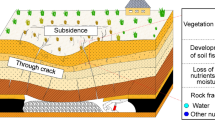Abstract.
Improving irrigation efficiency is of primary importance in arid and semi-arid regions of the world as a consequence of increasing incidences of soil and water salinisation. In the cotton-growing regions of Australia salinisation is generally a result of inefficient irrigation practices, which lead to excessive deep drainage (DD). There is therefore the need to apply a relatively inexpensive approach to assessing where inefficiencies occur and make prediction of suitability of existing and new water storage sites. However, physical methods of measuring DD, such as flux meters and lysimeters, are time-consuming and site-specific. In this paper we apply a rapid method for determining the spatial distribution of soil in an irrigated cotton field in the lower Gwydir valley. First, ECa data (using EM38 and EM31) were used to determine a soil-sampling scheme for determining soil information such as clay content and exchangeable cations to a depth of 1.2 m. The soil data and water quality information were input into the SaLF (salt and leaching fraction) model to estimate DD rate (mm/year). In developing the relationship between ECa and estimated DD, three exponential models (two-, three- and four-parameter) were compared and evaluated using the Aikakie information criteria (AIC). The three-parameter exponential model was found to be best and was used for further analysis. Using the geostatistical approach of multiple indicator kriging (MIK), maps of conditional probability of DD exceeding a critical cut-off value (i.e. 50, 75, 100 mm) were produced for various rates of irrigation (I=300, 600, 1,200 and 1,500 mm/year). The areas of highest risk were consistent with where water-use efficiency was problematic and thus leading to the creation of perched water tables. The advantage of this approach is that it is quick and is applicable to situations where efficient use of water is required. The results can be used for irrigation planning, particularly in the location of large irrigation infrastructure such as water reservoirs.
Similar content being viewed by others
Author information
Authors and Affiliations
Additional information
Electronic Publication
Rights and permissions
About this article
Cite this article
Triantafilis, .J., Huckel, .A. & Odeh, .I. Field-scale assessment of deep drainage risk. Irrig Sci 21, 183–192 (2003). https://doi.org/10.1007/s00271-002-0063-1
Received:
Accepted:
Issue Date:
DOI: https://doi.org/10.1007/s00271-002-0063-1




